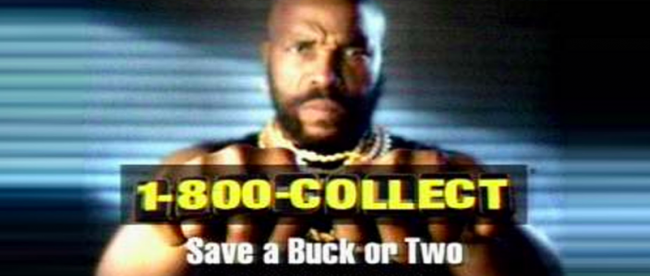The Battle Over the Collect Call

As mobile phones have become increasingly common, collect calls (known as “reverse charge calls” outside the U.S., Canada, and for some reason, Pakistan) have become increasingly rare. If you don’t know what they are, well, here’s a brief rundown.
Until relatively recently, when you made a phone call — and this was particularly true at payphones (obviously) and for long-distance calls from home, work, etc. — you paid the phone company a small amount to connect your call. But what if you couldn’t afford it? Or if you were at the payphone and, uh oh, you don’t have a dime? Enter the collect call. Just dial the operator and ask to be connected with the other party at their expense. The operator would ask the person you were calling to accept the charges and if he or she said okay, you’re good to go.
For the phone companies, connecting collect calls was a rather profitable business. (And to be clear, it still is — collect calls most definitely still exists. They’re typically used by inmates in prisons and there’s a lot of controversy around them; you can read more about that here.) And by “phone companies,” in the United States at the time, that meant AT&T. Because when you’d dial 0 for the operator, that’s the company that was almost always handling your request for a collect call.
That changed in May of 1993 when MCI, a smaller telecom company, emerged on the scene with a new product, called 1-800-COLLECT. Unlike operator-assisted calls, 1-800-COLLECT was entirely automated, allowing MCI to connect your call at as much as a 40% discount. (It also allowed for people to game the system; when prompted for your name, it was easy to forgo saying “Dan Lewis” and instead say “Dad-I’m-making-the-4pm-train-pick-me-up-at-530.” But that’s another story for another day.) And if you were living in the U.S. at the time, you certainly know about 1-800-COLLECT because the ads for it were everywhere. (Even Bart Simpson got involved.) That’s probably because MCI knew it could have a winner on its hands — if they could gain market share quickly enough.
That wasn’t a given. MCI’s technology was transformative, sure, but it was easily replicable. MCI built it in about three months and they figured that AT&T could get a competitor up and running shortly thereafter. And they were right. On July 4, 1993, AT&T launched 1-800-OPERATOR, their own automated collect calling system. Travel writer Peter S. Greenberg tested both out, finding the experience similar and the costs nearly identical — a five-minute call from New York to Los Angeles cost $2.30 with MCI’s and $2.29 with AT&T’s service; and eight-minute call from Washington to Dallas ran $3.41 using AT&T and a penny more with 1-800-COLLECT.
But AT&T’s product had one small problem — it’s phone number was much harder to spell. Specifically, the word “operator” proved problematic — it ends with -or, but many dialers thought it ended with -er. And AT&T didn’t think to register 1-800-OPERATER. But according to the Washington Post, MCI did. While the Post reported that MCI didn’t do anything with the number — if you called it, “it just rang and rang “ — industry news sources claimed otherwise. According to Network World, citing an MCI engineer, “MCI swept up about $500,000 [from the misdialed number] in the first month” after AT&T launched 1-800-OPERATOR launched.
Ultimately, AT&T had little choice but to give up on 1-800-OPERATOR — it was giving up too much money and it was going directly to the competition. Within a year, they launched the same service under a new number — 1-800-CALL-ATT.
Bonus fact: “Call your mom” is a common piece of advice. And it’s one Americans take to heart — according to various reports, in the United States, the day with the most phone calls made is Mother’s Day. But it’s not the day that most collect calls are made. That honor, according to rumor-debunking (and in this case, rumor-confirming) website Snopes.com, usually goes to Father’s Day. Despite the fact that moms get more calls overall, more dads get asked to pay for theirs.
From the Archives: Pumping the Phone: How free conference call services make money.
